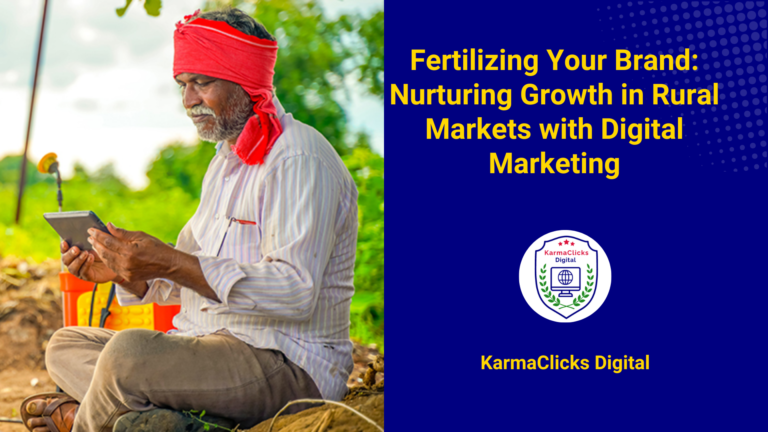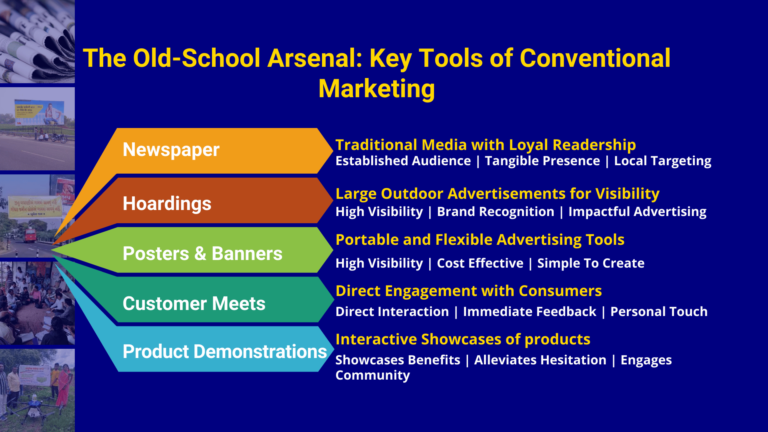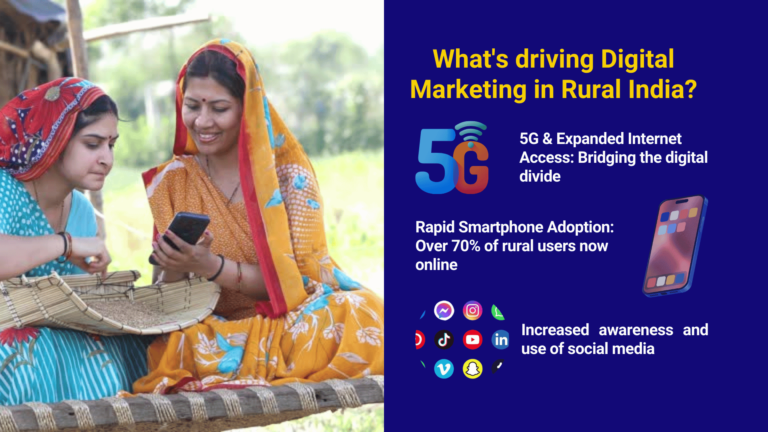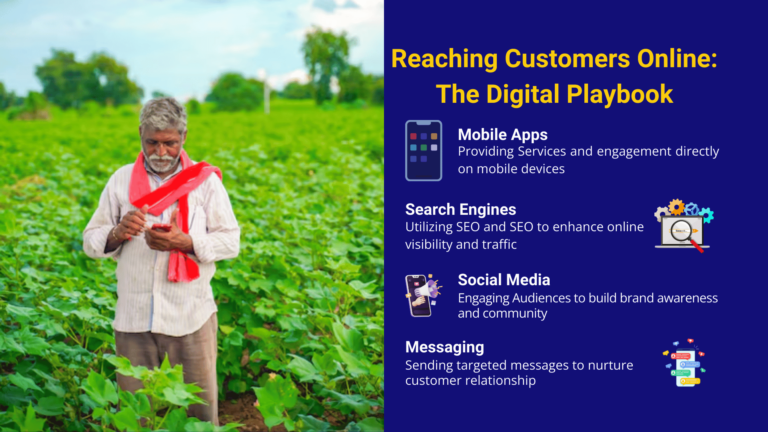Table of Contents
ToggleIntroduction

Marketing plays a critical role in the success of any business, and for those navigating the unique challenges of rural markets, selecting the right strategy is even more crucial. Traditional marketing methods like TV or newspaper ads, while effective to some extent, often come with high costs and delayed results, making them less viable for small businesses. The expense and uncertainty associated with conventional advertising usually discourage rural entrepreneurs and small enterprises from experimenting with new approaches.
This is where digital marketing steps in as a game-changer. With the ability to offer precise targeting, real-time analytics, and measurable outcomes—all at a fraction of the cost—digital marketing provides a smarter, more efficient way to reach customers. It bridges the gap between businesses and their audiences and offers tools that make marketing more interactive and effective, especially in rural areas where traditional methods face limitations.
In this blog, we’ll explore how digital marketing can revolutionize the way rural businesses and small enterprises approach marketing. From addressing the challenges of conventional marketing to showcasing actionable strategies and tailored solutions, we’ll delve into why digital marketing is the future of rural marketing. Whether you’re an agribusiness owner, a farm machinery or agri-input dealer, or a small-scale entrepreneur, this guide will equip you with insights to elevate your business and foster growth in today’s competitive landscape.
The Challenges of Rural Marketing

Marketing in rural areas comes with a unique set of challenges, requiring businesses to adopt customized and strategic approaches to create a meaningful impact. Unlike urban markets, rural regions demand marketing solutions that address their distinct characteristics while remaining cost-effective. Let’s explore the key factors that make rural marketing such a tough terrain.
Population Density
Rural areas are characterized by low population density, with customers scattered across vast landscapes. Unlike urban regions with concentrated markets, reaching rural audiences often involves higher logistical costs, extended travel times, and additional effort. Market sizes and distribution vary significantly, making it essential for businesses to adapt their strategies to specific local conditions.
Infrastructure Access
Limited access to infrastructure is another significant hurdle. Many rural areas face challenges such as poor road connectivity, inconsistent electricity supply, and inadequate telecom coverage. These limitations make it difficult to implement traditional marketing methods, such as print or outdoor advertising, effectively. They also restrict the use of digital tools without reliable internet access, highlighting the need for hybrid strategies tailored to available resources.
Cultural Dynamics
Rural India is incredibly diverse, with languages, traditions, and customs shifting every few kilometers. Generic marketing messages often fail to resonate, as they may be interpreted differently across regions. Successful rural marketing requires a deep understanding of local cultural nuances to craft messages that connect authentically with the audience.
The Rural Consumer Mindset
The buying behavior of rural consumers is often unpredictable and varies greatly from one region to another. Factors such as seasonal income cycles, trust in local influencers, and reliance on community recommendations shape purchasing decisions. Marketing efforts need to be relatable, consistent, and focused on building long-term trust to engage effectively with this audience.
Navigating this intricate landscape calls for innovative, flexible, and highly localized marketing strategies. Businesses must overcome these challenges with tailored approaches that not only reach rural consumers but also build lasting relationships. By addressing these factors, enterprises can unlock the vast potential of rural markets and create sustainable growth opportunities.
Conventional Marketing Methods and Their Shortcomings
Traditional marketing methods have long been the cornerstone of rural customer engagement, helping businesses build local connections and establish their presence. These time-tested tools include newspapers, hoardings, posters, customer meets, and product demonstrations. While they offer certain advantages, their limitations in today’s fast-evolving market landscape highlight the need for more dynamic solutions.

Conventional Marketing Methods
Newspapers
Newspapers remain a trusted medium in rural areas, providing a tangible presence and a loyal readership. They allow businesses to target specific regions effectively. However, their high costs, limited lifespan, and static messaging restrict their impact.
Hoardings
Large outdoor advertisements like hoardings capture significant visibility and help boost brand recognition. Despite their high visibility, hoardings are expensive to set up and maintain. Their effectiveness is often limited to specific locations, and they are vulnerable to weather conditions, which can reduce their longevity.
Posters and Banners
Portable and cost-effective, posters and banners are popular tools for local promotions. However, they are prone to wear and tear, including defacement or fading over time. They often fail to engage customers meaningfully, leaving little lasting impression.
Customer Meets
Personal engagement through customer meetings allows businesses to build relationships and gather immediate feedback. Yet, these events have high logistical costs and frequently attract limited attendance, reducing their overall effectiveness.
Product Demonstrations
Demonstrating products directly to potential customers helps showcase benefits and alleviate doubts. However, this method demands significant resources and often struggles to draw large or diverse audiences, limiting its scalability.
The Shortcomings of Conventional Methods
Despite their strengths, traditional marketing tools face critical limitations:
- High Costs: The expenses involved in methods like hoardings, newspaper ads, and customer meets often outweigh their returns, especially for small enterprises.
- Limited Reach: Traditional tools are confined by geography and infrastructure, making it challenging to reach scattered rural populations effectively.
- Generic Messaging: With minimal scope for personalization, traditional methods often fail to resonate deeply with diverse rural audiences.
- Low Engagement: Tools like banners and posters lack interactive elements, leading to superficial customer connections.
- Absence of Analytics: Traditional methods provide little to no insight into their effectiveness, leaving businesses unable to measure their return on investment or refine their strategies.
While these tools have been pivotal in rural marketing, their inefficiencies highlight the need for more targeted, cost-effective, and measurable solutions. Digital marketing bridges these gaps by offering scalable, personalized, and impactful strategies that cater to rural businesses’ unique needs.
The Rise of Digital Marketing in Rural India
Digital marketing is no longer confined to urban areas; it is rapidly transforming rural India by bridging the gap between businesses and their audiences in even the remotest locations. A wave of technological advancements has made digital marketing an accessible and powerful tool for rural businesses. Let’s explore the key drivers of this digital revolution.

5G and Expanded Internet Access
The introduction and expansion of 5G networks have revolutionized connectivity in rural India. Faster and more reliable internet access is reaching remote villages, enabling businesses and individuals to tap into the vast resources of the digital world. This improved connectivity allows businesses to access untapped markets with significant growth potential. For rural enterprises, the digital landscape is no longer out of reach—it is now a critical part of their strategy to connect with wider audiences.
Rapid Smartphone Adoption
Smartphones have become an integral part of rural life, driving the digital shift. As of January 2023, over 425 million rural Indians own smartphones, accounting for 42% of the country’s total smartphone users. Additionally, 88% of rural households rely on these devices for accessing information, shopping, and entertainment. Smartphones are no longer just communication tools; they are gateways to e-commerce, social media, and digital campaigns. This widespread adoption makes digital marketing campaigns more impactful and ensures greater reach within rural communities.
Increased Social Media Usage
Social media platforms like Facebook, WhatsApp, and Instagram have emerged as game-changers in rural marketing. They enable businesses to engage directly with consumers through targeted campaigns and community groups. These platforms facilitate personalized interactions, helping businesses build trust and foster long-term relationships. Social media’s interactive nature allows for real-time feedback, making it an invaluable tool for marketing in dynamic rural markets.
The Impact on Rural Marketing
The convergence of these factors—5G connectivity, smartphone adoption, and social media growth—has revolutionized rural marketing. Digital marketing is now:
- Efficient: Cost-effective strategies make it accessible even for small enterprises.
- Scalable: Businesses can reach larger, more dispersed audiences without geographical limitations.
- Interactive: Real-time engagement builds trust and creates meaningful connections with rural consumers.
By leveraging these advancements, businesses in rural India can adopt digital marketing to overcome traditional challenges, maximize reach, and drive sustainable growth. The digital wave is no longer just an urban phenomenon; it is a rural revolution that is here to stay.
The Digital Playbook: Tools and Benefits
The digital era has ushered in smarter, more efficient ways to engage with audiences, offering businesses the opportunity to connect with rural consumers like never before. The Digital Playbook combines versatile tools and innovative strategies to maximize reach, engagement, and ROI. Let’s dive into the key tools and their transformative benefits.
Key Tools in the Digital Playbook

Mobile Apps
Mobile apps are an essential tool for direct and personalized engagement. They provide users with easy access to services and information on the go, ensuring consistent interaction and building brand loyalty.
Search Engines
Search engines are the backbone of online visibility. With effective SEO strategies, businesses can ensure they appear at the top of search results, making it easy for customers to find them. Enhanced visibility drives targeted traffic to websites, turning searches into sales opportunities.
Social Media Platforms
Social media platforms like Facebook, Instagram, and WhatsApp are crucial for building brand awareness, fostering community, and engaging audiences through interactive campaigns. These platforms allow businesses to communicate directly with consumers, creating meaningful connections.
Messaging Platforms
Messaging apps like WhatsApp offer a powerful channel for personalized communication. Businesses can share updates, promotional offers, and service information, maintaining direct and engaging relationships with customers.
Core Benefits of Digital Marketing

Cost-Effectiveness
Digital marketing provides a high return on investment compared to traditional methods. For instance, a single full-page newspaper ad can cost around ₹1 lakh and reach 20,000–50,000 readers, whereas a Facebook Ad campaign with a budget as low as ₹500 per day can generate 70,000–100,000 targeted impressions.
Targeted Reach
Advanced tools enable businesses to reach specific demographics by tailoring campaigns based on location, interests, language, and behaviour. This precision ensures that every rupee spent reaches the right audience.
Measurable Results
Unlike traditional marketing, where effectiveness is often hard to gauge, digital marketing provides detailed metrics. Businesses can track every click, view, and interaction, enabling them to understand campaign performance and optimize strategies in real-time.
Real-Time Analytics
With digital tools, businesses can monitor campaign performance instantly. If a campaign isn’t delivering the desired results, adjustments can be made mid-way to save time and resources.
Digital Tools vs. Traditional Marketing
Facebook Ads vs. Newspapers
Traditional newspaper ads are limited by circulation areas and have a short lifespan.
In contrast, Facebook Ads provide interactive engagement, precise targeting, and measurable metrics.
For example, a ₹3,500 week-long Facebook campaign can outperform a costly newspaper ad by reaching a more relevant audience with dynamic content.
WhatsApp Marketing vs. Telemarketing
Telemarketing often results in low engagement due to interruptions and high costs (₹15,000–₹20,000 for 1,000 calls).
On the other hand, WhatsApp Marketing, with a 98% open rate, costs as little as ₹500 for 1,000 messages.
Its non-intrusive, customizable nature, combined with multimedia capabilities, makes it a clear winner.
Digital Marketing: The Gameplan
In the digital marketing landscape, success begins with a well-structured Digital Ecosystem—a seamless framework designed to attract, engage, and convert potential customers.
At the heart of this ecosystem lies the sales funnel, a strategic model that guides prospects from discovery to conversion.
Let’s break down this game plan and understand how each component contributes to your digital success.

The Sales Funnel: A Step-by-Step Guide
At the top of the sales funnel is your website, the cornerstone of your digital presence. Think of it as your virtual storefront, showcasing everything your business offers—from products and services to customer testimonials and blogs.
An effective website is not just about aesthetics; it’s about functionality. It should:
- Provide detailed information about your offerings.
- Highlight compelling customer testimonials for social proof.
- Feature engaging blogs to educate and inform your audience.
Include clear Call-to-Action (CTA) links like “Buy Now,” “Learn More,” or “Contact Us” to guide visitors toward taking the next step.
Driving Traffic to Your Website
Traffic is the lifeblood of your digital marketing ecosystem, and it flows from two primary sources:
Organic Traffic
Organic traffic is generated without direct advertising costs, making it a sustainable way to build long-term visibility.
Search Engine Optimization (SEO)
By optimizing your website for search engines, you ensure it ranks higher on Google, YouTube and other platforms, increasing the likelihood of discovery. SEO strategies include keyword optimization, creating high-quality content, and enhancing your website’s technical performance.
Social Media Optimization (SMO)
Active and optimized social media profiles direct followers to your website, creating a steady stream of traffic. Platforms like Facebook, Instagram, and LinkedIn play a pivotal role in engaging audiences and nurturing trust.
Inorganic Traffic
For faster results, paid advertising delivers a direct route to your target audience.
Search Engine Marketing (SEM)
Platforms like Google Ads and YouTube Ads position your business at the top of search results, targeting users searching for specific keywords.
Social Media Marketing (SMM)
Ads on Facebook and Instagram allow you to reach a tailored audience based on demographics, interests, and online behavior.
Converting Visitors into Customers
Once visitors arrive at your website, the sales funnel takes over, guiding them through the customer journey:
- Awareness: Visitors discover your brand through engaging content and ads.
- Interest: They explore your offerings, read testimonials, and engage with your blogs.
- Desire: Clear CTAs and visually appealing content build trust and motivate action.
- Action: Visitors complete their journey by purchasing a product, signing up, or contacting you.
A well-executed digital marketing game plan turns your website into a magnet for leads, your content into a tool for engagement, and your ads into a catalyst for conversions. By blending organic and inorganic strategies, the sales funnel ensures you capture, nurture, and convert your audience effectively. This game plan isn’t just a strategy; it’s your roadmap to digital success.
Digital Marketing: Strategic Approach

A robust digital marketing strategy is essential for turning your game plan into actionable, impactful results.
With a well-structured approach, you can create a dynamic Digital Ecosystem, attract potential customers, and drive conversions.
Here’s a step-by-step guide to crafting a strategic digital marketing plan.
Set Up Your Digital Ecosystem
Begin by establishing a strong foundation for your digital presence.
- Website Design and Optimization: Ensure your website includes essential pages such as services, products, blogs, and testimonials. Optimize it for speed, mobile responsiveness, and SEO to rank higher on search engines.
- Social Media Optimization (SMO): Create and optimize social media accounts on platforms like Facebook, Instagram, and LinkedIn. Ensure seamless integration between your social platforms and website to drive traffic.
Fuel Your Ecosystem with Consistent Content
Content is the fuel that powers your Digital Ecosystem.
- Regular Content Creation: Share engaging content on social media, including posts, reels, and stories. Update your blog with fresh, relevant articles.
- Community Engagement: Respond to comments, participate in discussions, and foster relationships through platforms like Facebook Groups. Building a loyal community strengthens your brand presence and trust.
Implement a Lead Management System
Lead nurturing is crucial for converting interest into sales.
- Group Messaging: Set up WhatsApp or Telegram groups to share updates, testimonials, and promotional offers.
- Automation Tools: Use chatbots or CRM systems to automate responses and maintain high levels of responsiveness. Automation ensures you can efficiently manage interactions without compromising on quality.
Scale Up with Paid Campaigns
Paid advertisements can accelerate growth and enhance visibility.
- Google Ads: Reach potential customers actively searching for your products or services.
- Social Media Ads: Use Facebook and Instagram Ads to target specific demographics, interests, and behaviors. Paid campaigns provide faster results, helping you expand your audience base effectively.
Focus on Analytics and Tracking
Monitoring performance is key to refining your strategy.
- Tracking Tools: Use platforms like Google Analytics, Facebook Insights, and social media dashboards to measure campaign performance.
- Data-Driven Decisions: Analyze reports regularly to understand what works and what doesn’t. Refine your strategies to maximize ROI and ensure measurable growth.
Incorporate Automation
Integrating automation tools at every stage of your strategy helps streamline operations. From chatbots for instant responses to analytics tools for automated reporting, automation saves time and ensures consistent, professional execution.
Outsource When Needed
If managing all these tasks manually feels overwhelming, consider outsourcing specific activities to skilled professionals. This ensures consistency, quality, and measurable outcomes while allowing you to focus on your core business.
By setting up a comprehensive Digital Ecosystem, nurturing leads, leveraging paid ads, and prioritizing analytics, your digital marketing efforts will be both efficient and impactful. This strategic approach not only saves time but also drives sustainable growth, positioning your business for long-term success.
Conclusion
Digital marketing has emerged as a transformative force, bridging the gaps that traditional marketing often struggles to address. It offers rural businesses and small enterprises the tools to overcome challenges such as limited reach, high costs, and generic messaging. By leveraging digital platforms, businesses can achieve targeted engagement, measurable results, and cost-effective solutions that drive growth.
From setting up a robust Digital Ecosystem to implementing powerful strategies like SEO, social media optimization, and paid campaigns, digital marketing ensures that every effort is impactful and results-driven. Tools like real-time analytics and automation further refine these strategies, making them efficient and scalable.
